Chimney Sweeping
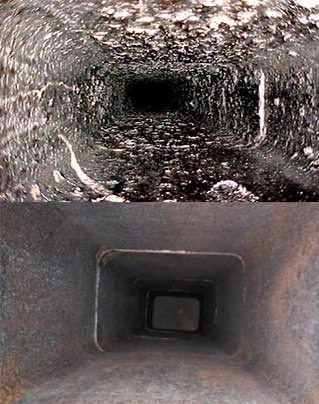
Soot/Creosote
When you are burning ANY solid fuel appliance, you can build up a substance called soot or creosote. This substance is VERY FLAMMABLE, as it is leftover fuel that does not combust when you burn. If soot or creosote burns, you may experience what most people call a chimney fire. Chimney fires are a very dangerous situation. Not only can a chimney fire cause damage to the interior of the chimney system, causing it to fail and not vent properly, structure (house) fires can start from a chimney fire event. Every year, thousands of chimney fires occur, causing millions of dollars in damage, including lost possessions, lost memories, and lost lives, all as the result of improperly used and maintained solid-fuel heating systems which help cause chimney fires.
Wood Burning Fireplaces
Wood burning fireplaces are a common cleaning service for Top Hat. Wood burning fireplaces can add elegance and ambiance to your living room. While wood burning fireplaces might be beautiful to look at while having a fire, they are one of the most inefficient wood burning appliances still available today. The fireplace chimney requires a tremendous amount of the heat and combustibles being produced to actually go up the chimney for the fireplace to function properly. Most of the time, if a fireplace is built to give off more heat, it causes more soot to build up in the chimney. For this reason, fireplaces need annual inspection and cleaning.
Free Standing Wood Burning Stoves
Free Standing Wood Burning Stoves are more efficient in terms of heat recovery than a fireplace. Heat recovery can have drawbacks in terms of creosote production. In older woodstove installations, the stove pipe is breached directly into an existing masonry chimney. Many times the chimney is too big for the stove and problems can arise, other times the stove itself is siphoning heat away from thechimney leading to poor performance. This siphoning of heat also leads to unnecessary cooling of the gases in the chimney and causes the creosote to condense more rapidly than in a traditional fireplace system. It is HIGHLY recommended that woodstove chimneys be inspected AT LEAST once a year and cleaned when necessary. If you use your woodstove as a source of heat during the cooler months you may even find that multiple cleanings are necessary during a heating season.
Wood Burning Fireplace Inserts
Wood burning fireplace inserts are a great way to increase the efficiency of your fireplace. However, like free standing wood burning stoves, they are subject to the same problems when it comes to creosote buildup. Many times we find that older fireplace inserts were installed without a properly sized lining system in the chimney. Fireplace flues were meant to vent inefficient fireplaces, NOT more efficient wood burning inserts. This leads to an extreme oversizing/cooling process of the flue gases and can create a very dangerous situation in your home. Wood burning inserts, without a properly sized and installed metal liner are a very HIGH RISK flue fire probability. These systems must be inspected annually for many reasons and if a properly sized and installed liner is not present, they system should not be used.
Wood Pellet/Corn Burners
Wood Pellets and Corn are an excellent source of heat for your home. They are also great for the environment because wood and corn are renewable. Wood Pellet and Corn stoves are very easy to use and very efficient in terms of wood burning and heat recovery. Pellet stoves are not like traditional wood stoves due to the mechanics inside the stove. Just like a forced air furnace, there are many different parts that need regular maintenance such as combustion fans, overheat switches, gaskets, vacuum switches, auger motors and more. Even though these stoves are usually more efficient, there is still a great amount of ash/soot that builds up in the flue. These stoves and their accompanying parts need to be checked / cleaned as well as the exhaust vent cleaned regularly.
Coal Chimneys
Another common type of heating fuel is coal. Coal can be a wonderful form of heat for your home and is popular in Pennsylvania. Coal burning produces a significant amount of coal ash and in some systems, a form of soot can even accumulate. Even the smallest spark can ignite a chimney fire or dust explosion in the chimney if the conditions are right.
There are many types of coal fuel including bituminous (“soft”) coal and anthracite (“hard”) coal.
Bituminous coal found in Western Pennsylvania and just about every other state in the U.S. It does produce a lot of smoke, a form of coal soot and a powerful sulfury odor.
Anthracite coal is the highest grade of coal and is almost purely carbon. Anthracite coal does not contain the impurities found in bituminous coal and is almost exclusively mined in Northeastern Pennsylvania.
Both types produce significant amounts of ash which should be cleaned regularly from the heating system (stove, pipes and chimney).
Coal ash/soot can be dangerous for 3 reasons:
- Coal soot can be flammable.
- Coal flue blockages due to either a buildup or a flue fire can be fatal to people and pets if coal gases, which contain carbon monoxide, cannot escape through the flue.
- If enough coal dust is built up inside your chimney flue, you run the risk of a dust explosion which will severely damage the chimney.
As such, it is important to have your coal venting chimney inspected annually and cleaned when necessary. Special types of brushes are used when sweeping coal flues, so not to create any sparks. In addition, a carbon monoxide detector with digital readout is strongly recommended. Carbon Monoxide is deadly.
Oil Furnace Flues
Fuel Oil is a common type of heating fuel. When fuel oil is burned, several types of emissions can occur. Carbon Monoxide can be produced, but also something called Sulfur Oxides. Depending on the sulfur content of the fuel oil, some of these sulfur oxides can react readily with moisture (do you have a rain cap on your chimney?) forming a sulfuric acid mist inside of the chimney. This acid can cause the interior of the chimney to deteriorate rapidly. If your chimney is deteriorated and not functioning properly, your oil furnace can malfunction and/or your chimney could be letting dangerous gases into your home. For this reason, it is important to have your oil furnace chimney inspected and cleaned regularly. Note: This is NOT a service that the furnace companies do. They service your furnace. Top Hat services your chimney.
Note: If you see white spots on the outside of your oil venting chimney, it is an indication that a new lining system needs to be installed right away before even more serious damage is done. A liner now can save a liner & a rebuild later!
Gas Furnace/Appliances
Gas appliance flues are a little different from other types of chimneys and appliances listed above. Very rarely is soot produced unless you have a VERY SERIOUS PROBLEM with your appliance. This does NOT mean these chimney flues do not need service, they do! Gas Flues need annual inspection and a different type of cleaning/neutralization. We commonly end up cleaning a gas flue when there is a blockage due to animals, leaves and debris, or a deteriorated chimney!
Typically, when you have a gas fired furnace, boiler, or water heater, your chimney is venting carbon monoxide and water. The water (a weak form of hydrochloric acid and sulfuric acid ) that is being produced is usually vented to the atmosphere as steam in a properly installed heating/venting system.
Many times the chimney flue is too big for the appliance and the flue doesn’t get hot enough to vent all of the water vapor out. That water (a weak form of hydrochloric acid and sulfuric acid), is trapped in the chimney and causes deterioration in the chimney liner and can cause damage to the exterior of the chimney and the house walls too! A deteriorated chimney can malfunction and not vent properly. It can even cause your heating appliances to malfunction.
Note: If you see white spots on the outside of your gas venting chimney – this is an indication that a new lining system needs to be installed right away, before even more serious damage is done. A liner now can save thousands of dollars in a chimney rebuild AND a liner later!
Inspections
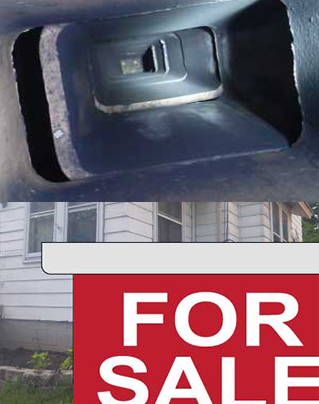
Regular Inspection (Annual)
A regular chimney inspection is always performed at the time of your annual chimney cleaning.There are cases when your chimney will not need to be cleaned but all chimneys need an inspection to insure safe use. All solid fuel fired chimneys (wood, coal, oil, propane, pellet and corn), as well as gas chimneys should be cleaned and/or inspected annually. The chimney top, exterior, interior (flue), firebox, dampers, and smoke chamber (in the case of a fireplace), and connectors (vent connectors for heating appliances such as a furnace, water heater or boiler, or stove pipe connectors for free standing wood burners and hearth stoves) are all parts which are inspected with your annual checkup. Additionally, clearances to combustibles in all chimneys, and many more parts need to be checked for proper installation, as well as looking for general deterioration prior to use of any chimney.
Diagnostic Inspections
Diagnostic chimney inspections are performed when your fireplace, stove, and/or chimney are not working properly. Diagnostic Inspections are used to do just that, diagnose problems and provide you with a solutions. Just like when you go to the doctor when you feel bad and your doctor gives you a checkup to see what’s going on before he or she writes you a prescription.
Real Estate Transaction Inspections
There are a two sides of performing a chimney inspection prior to selling or buying a house. We recommend an inspection be performed on ALL REAL ESTATE TRANSACTIONS to protect the parties involved.
From a Buyer Standpoint – A buyer will hire us to perform a real estate chimney inspection, prior to buying a house, so that any problems or potential problems are identified prior to them being responsible for the cost of any repairs.
From a Seller Standpoint – A seller will hire us, usually prior to putting the home up for sale, to plan for any problems or potential problems that might come up during the sale. This pre-emptive approach can lead to a smoother home selling / buying experience.
Real Estate Chimney Inspections, can protect both the buyer and seller.
New Appliance Chimney Inspections
Chimney inspections are recommended when you have to change your heating appliance. It is important to make sure that the chimney is compatible with the new appliance to avoid costly damage or equipment malfunctions. Many times newer high efficiency appliances need a smaller chimney to avoid condensation issues. Fuel Oil, Propane, Natural Gas, and Woodstove appliances are extremely susceptible to water, sulfur, and creosote condensation when a properly sized chimney is not used. All new furnaces vented into masonry chimneys require a properly sized lining system be installed as a requirement of the furnace installation!
Chimney Caps
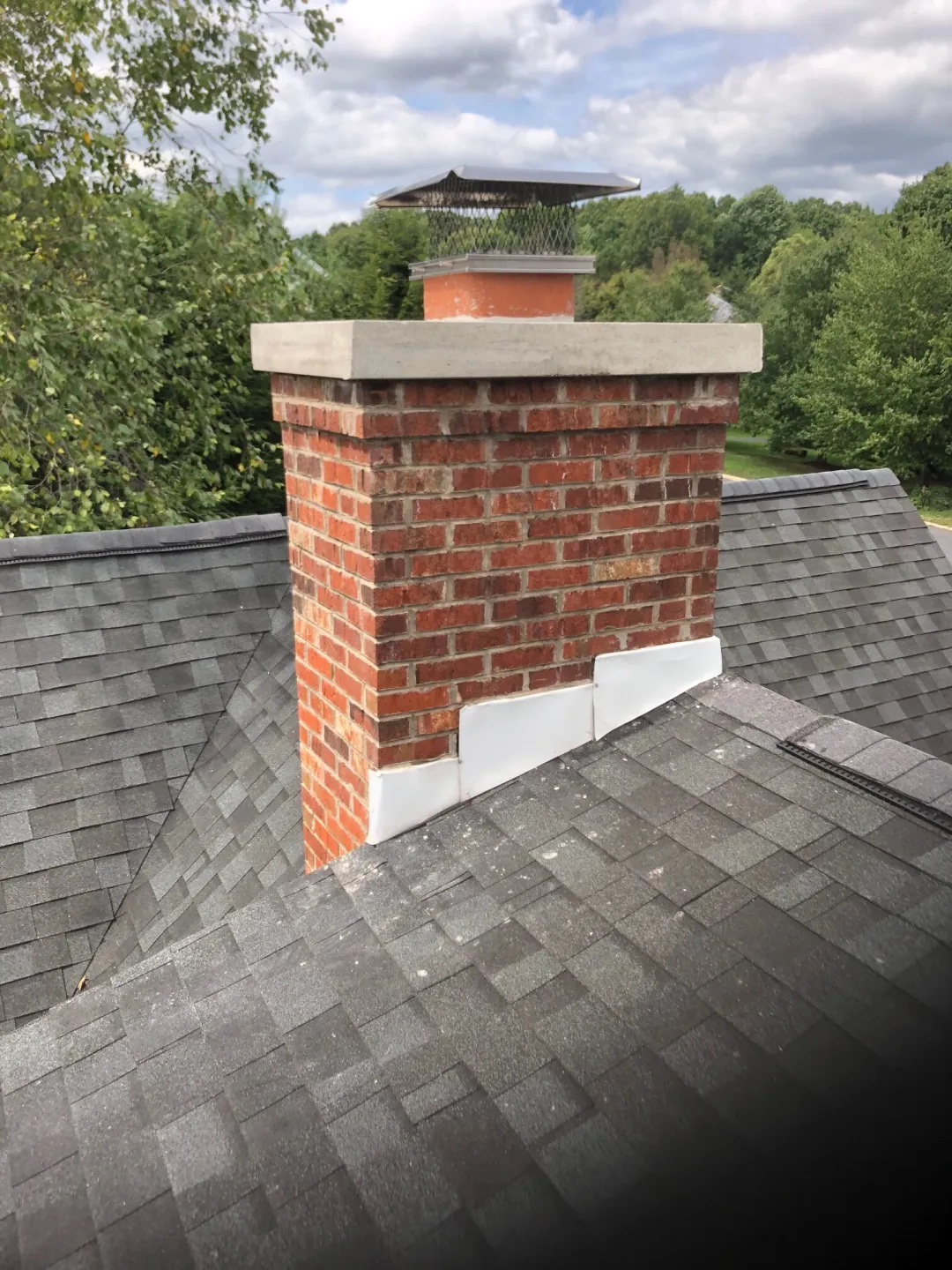
Rain and Animal Guards are an important addition to your chimney system. They provide several different safeguards.
- First of all they protect your chimney against the rain. Water is the natural enemy of masonry, the more water you can keep out of you chimney the better. Water can mix with the byproducts of combustion and produce acids that basically eat your chimney from the inside out.
- Secondly, flue caps keep animals out of your chimney. Squirrels, bats, birds, raccoons, and even ducks… yes ducks, will nest in chimneys. It is important to keep these animals out so that they do not build nests and plug up your chimney causing dangerous situations.
- The third protection is keeping water out of your house. Excess water which falls into or soaks into the chimney finds its way into many houses. Water leaks on the ceiling by the chimney, wet walls located by the chimney, pooling water running out of the chimney into the home are all made worse by the lack of a proper rain cap on top of the chimney.
Top Hat installs a variety of flue caps to meet your individual home’s needs. Stainless Steel and Copper Caps will last a lifetime protecting your chimney from rain and animals.
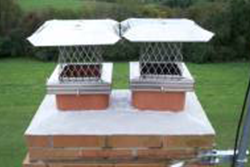
Stainless Steel Single Flue Caps
Single flue stainless steel flue caps come in a variety of sizes and fit directly on to the top of the flue tile. In case there is no top tile or it is too short to accept a cap, mounting legs can be installed to attach the cap inside the flue.
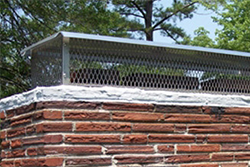
Multi Flue Caps
Available in either stainless steel or copper, these caps are designed to fit on a chimney that has multiple flues running through it. These are available in several ready-made sizes, however they can be custom made to fit your individual chimney.
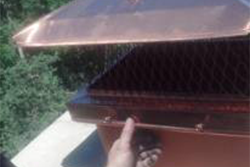
Copper Flue Caps
Copper caps offer the same benefits as the stainless steel caps above, but copper can add a touch of elegance to your home. The caps will weather, over time, to a rustic copper tarnish look that can certainly add an accent to any chimney or home.
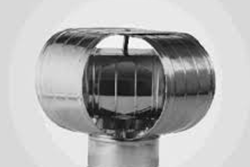
Specialty Flue Caps
Specialty flue caps are used for the special needs of chimneys, such as chimneys that do not draft well or existing chimney caps that do not preform as intended. Top Hat can make a determination if a specialty flue cap is needed on your chimney.
Chimney Flash Repair
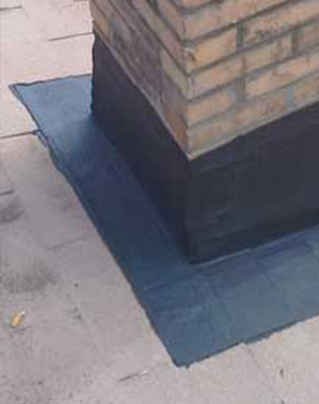
Chimney Flashing Materials
Chimney flashings are usually made from a durable material, then often sealed with a flexible sealant such as tar, silicone, polyeurathane…etc.
Chimney flashing can be made from galvanized steel, stainless steel, copper, lead, aluminum or even vinyl.
Leaking Caused by Chimney Flashing
The most common type used in older homes in the Pennsylvania area is galvanized steel. Galvanized steel will hold up for a number of years, but eventually, due to the extreme weather climates will fail. Holes can rust into the flashing cause your chimney to leak water.
Another way the chimney flashing can leak is incorrect installation. The chimney flashing should be installed into a groove cut into the brick and sealed with a high grade sealant. We often find that the flashing has not be cut in. This can allow water that penetrates the brick and mortar to seep in right behind the flashing and into the house. Chimneys that are very wide where the down slope of the roof meets the chimney should have a “saddle flashing” installed to direct water around the chimney masonry, instead of pooling up or “damming” behind the chimney and getting under the shingles.
Top Hat can repair your chimney flashing to help prevent water leaks for years to come!
Hat inspects many types of chimneys: wood, oil, coal and gas, just to name a few. There are many parts to chimneys and many things that can make your chimney not suitable for use. Keep reading or use the menu on the left to find out more.
CHimney Damper Repair And Installation
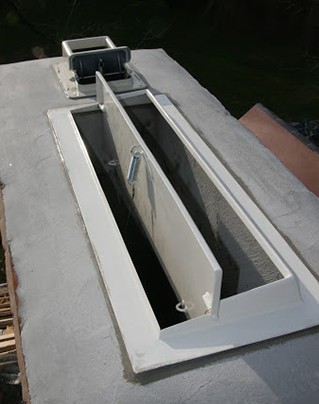
Top mounted stainless steel flue dampers can save you money!
Does your damper not work right? Is it stuck open or even worse, closed? Your damper is an integral part of your fireplace or woodstove heating system. When the stove or fireplace is not in use, it is the damper’s job to keep air in the house from escaping through the chimney. If your damper does not work correctly you could be losing money through the chimney in the form of your heating and cooling bills.
If the damper is unstable it could close in the middle of a fire and cause smoke damage to your house. In addition to that if the damper is installed incorrectly, sometimes the damper won’t open completely and can cause performance issues with your fireplace.
Top Hat offers a variety of solutions to repair or reinstall the damper in your heating appliances. Call today and stop throwing money up the chimney!
If you do need a replacement damper, our top mounted chimney dampers are of the highest quality. Stainless Steel construction, Rain and Animal Protection are included with our quality top mounted damper systems! The best news? They actually will pay for themselves in energy savings.
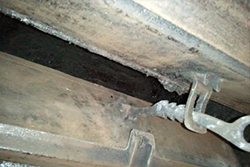
Fireplace Damper Repair
Older masonry fireplaces often have what are called “poker”-style dampers. These types of dampers are usually made from cast iron and are subject to breakage, wear and rust. In addition, these types of dampers are very inefficient.
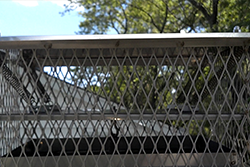
Top Mounted Dampers
If you do need a replacement damper, our top mounted chimney dampers are of the highest quality. Stainless Steel construction, Rain and Animal Protection are included with our quality top mounted damper systems.
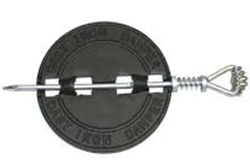
Stove Pipe Dampers
Stove pipe dampers are installed in the connector pipe that runs from your stove to your chimney. Usually these types of dampers are used in older stoves to control the draft. Newer, modern wood-stoves typically do not use pipe dampers.

Factory Built Fireplace Dampers
Dampers in factory built fireplaces are usually a thin metal plate that is at the top of the firebox. These thin metal plate dampers are subject to rust and warpage, causing malfunctions in the draft and/or smoke damage and smoke smells.
